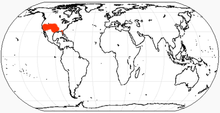Canis lepophagus
| Canis lepophagus Temporal range: Late Miocene–Early Pleistocene |
|
|---|---|
| Scientific classification | |
| Kingdom: | Animalia |
| Phylum: | Chordata |
| Class: | Mammalia |
| Order: | Carnivora |
| Family: | Canidae |
| Genus: | Canis |
| Species: | †C. lepophagus |
| Binomial name | |
|
†Canis lepophagus Johnston (1938) |
|
 |
|
| Range of Canis lepophagus based on fossil distribution | |
Canis lepophagus (Latin: canis: 'dog', leporem: 'hare' or 'rabbit', suffix -phagus: '-eating'; hence hare-eating dog) is an extinct species of canid which was endemic to much of North America. It is notable because its lineage is proposed to have led to both wolves and coyotes.
Early Pliocene in North America. There is general agreement on the most ancient record, which shows that Feliforms and Caniforms emerged within the super-family Carnivoramorpha 43 million YBP. The caniforms included the fox-like genus whose various species existed from 34 million YBP before branching 11.9 million YBP into vulpes (foxes) and canini (canines). The jackal-sized Eucyon existed in North America from 10 million YBP and by the Early Pliocene about 6-5 million YBP the coyote-like Eucyon davisi invaded Eurasia. In North America it gave rise to early Canis which first appeared in the Miocene (6 million YBP) in south-western USA and Mexico. By 5 million YBP the larger Canis lepophagus appeared in the same region and by the (1 million YBP) C. latrans (the Coyote) was in existence.They proposed that the progression from Eucyon davisi to C lepophagus to the Coyote was linear evolution.
Kurten proposed that the Blancan C. lepophagus derived from smaller Miocene Canis species in North America. It then became widespread across Eurasia where it was either identical to, or closely related with, C. arnensis of Europe.
Johnston describes C. lepophagus as having a more slender skull and skeleton than in the modern coyote. Nowak found that the early populations had small, delicate and narrowly proportioned skulls that resemble small coyotes and appear to be ancestral to C. latrans. Johnson noted that some specimens found in Cita Canyon, Texas had larger, broader skulls, and along with other fragments Nowak suggested that these were evolving into wolves.
...
Wikipedia
